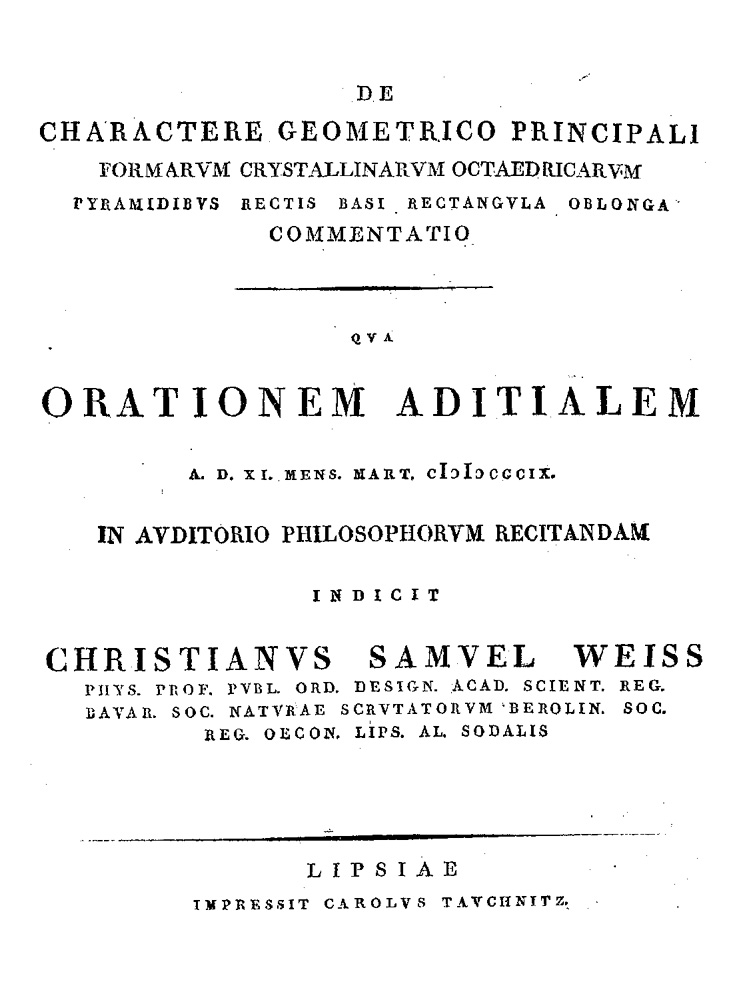WEISS, Christian Samuel.
(1780 – 1856)
Weiss was professor of mineralogy at the University of Berlin. He had been a student of Werner's at the Freiberg Bergakademie.
Biographical references: ADB: 41, 559. • Drugulin, Sechstausend Portraits, 1863: no. 6306. • DSB: 14, 239-42. • Hoppe, Günter., "Christian Samuel Weiss und das Berliner Mineralogische Museum," Wissenschaftliche Zeitschrift der Humboldt-Universität zu Berlin, Math.-Naturwiss. Reihe, 31 (1982), p. 245-254. • Hoppe, Günter., "Zur Geschichte der Geowissenschaften im Museum für Naturkunde zu Berlin. Teil 5: Vom Mineralogischen Museum im Hauptgebäude der Universität zu den zwei geowissenschaftlichen Institutionen im Museum für Naturkunde - 1856 bis 1910," Mitteilungen aus aus dem Museum für Naturkunde in Berlin. Geowissenschaftliche Reihe / Institut für Paläontologie; Institut für Mineralogie der Humboldt-Universität zu Berlin, 6 (2003), p. 3-51. • ISIS, 1913-65: 2, 617. • Lambrecht & Quenstedt, Catalogus, 1938: 454. • Poggendorff: 2, cols. 1287-9. • Sarjeant, Geologists, 1980: 3, 2397 & Suppl. 1 (1986), 2, 881.

1. Latin, 1809.
De Indagando | Formarvm Crystallinarvm | Charactere Geometrico Principali | Dissertaitio | [tapered rule] | Qvam | Amplissimi Philosophorvm Ordinis | Avctoritate | Pro Loco In Eo Obtinendo | A.D. Viii. Mens. Mart. cI{[Backwards c]I[Backwards c]cccix}. | E.L.Q.C. | Pvblice Defendet | Christianvs Samvel Weiss | [...3 lines of titles and memberships...] | Socio Fratre | Christiano Conrado Weiss | Lipsiensi | Med. Cvlt. | [tapered rule] | Lipsiae | Impressit Carolvs Tavchnitz.
4°: π1 A-F4 G2; 27l.; [2], [1]-52 p.
Contents: [2 pgs], Title page, verso blank.; [1]-5, "Introdvctio."; [6]-52, Text.
Very rare. Read as a dissertation upon Weiss' appointment to the Physics chair at Leipzig, this work helped lay the foundation of modern crystallographic studies. It outlines the differences between Haüy's prevailing crystallographic theories and the author's own ideas about the meaning of crystal symmetry. Haüy considered the relationship between crystal faces to be the fundemental indicator of geometric form. Weiss imporved upon this idea, by proposing instead a method for determing geometric characteristics by using the relationship between sines and cosines of the angle made between a crystal face and the crystallographic axes. By describing the faces of the crystals in relation to the three main axes that Weiss called a, b and c, he created an easy method of relative crystal face designation and orientation that is still adopted today. His theory pointed a clear direction for the future of crystallography, and its treatment of the geometry of crystalline forms.
French transl., 1811: "Dissertatio de Indagando formarum cristallinarum caractere geometrico principali, ou Mémoire sur la détermination du caractère geometrique principal des formes cristallines," in: Journal des Mines, 19 (1811), pp. 349-391 & 401-444. French translation by André Jean Marie Brochant de Villiers of Weiss' pioneer thesis.
Bibliographical references: BL [726.c.27.(1.)]. • Burke, Origins of the Science of Crystals, 1966: pp. 151-54 & 155-63. • Leonard's Taschenbuch: 5, p. 330. • Lima-de-Faria, Time-Maps of Crystallography, 1990: pp. 24 & 28. • LKG: IX 31.

2. Latin, 1809.
De | Charactere Geometrico | Principali | Formarvm Crystallinarvm Octaedricarvm | Pyramidibvs Rectis Basi Rectangvla Oblonga | Commentatio | [tapered rule] | Qva | Orationem Aditialem | A.D. XI Mens. Mart. cI{[Backwards c]I[Backwards c]cccix}. | In Avditorio Philosophorvm Recitandam | Indicit | Christianvs Samvel Weiss | [...3 lines of titles and memberships...] | [tapered rule] | Lipsiae | Impressit Carolvs Tavchnitz.
4°: π1 1-44; 17l.; [2], [1]-32 p.
Contents: [2 pgs], Title page, verso blank.; [1]-32, Text.
Very rare. In this thesis, which continues ideas expressed in the De Indagando Formarvm Crystallinarvm of the same year, Weiss emphasized the importance of direction in crystals, attributing their formation and rationality of crystal faces to a generating force that is directional in nature. Crystallographic axes had a physical significance and could therefore be used as the foundation of a system of crystal classification. Weiss proposed to classify crystals into four main systems, with subdivisions, by considering crystallographic axes mutually perpendicular to one another. He begins by dividing crystals into two principal categories. The first division consists of crystals with three axes, each perpendicular to the other two. Three possibilities were noted to occur in this division: 1) the lengths of all axes were equal, 2) the lengths of two axes were equal, while the third was either shorter or longer, and 3) the lengths or all three axes were different. By this means Weiss distinguished the present isometric, tetragonal, and orthorhombic crystal systems. The second major division Weiss noted consists of three equally spaced axes at right angles to a fourth axis. Currently, this is recognized as the hexagonal or trigonal crystal system.
Related work, 1815: Weiss continued to develop his theory, and in December, 1815, he read a memoir to the Academy of Berlin, titled: Uebersichliche Darstellung des verschiedenen natürlichen Abteilungen der Kristallisations-Systeme (see: Abhand. könig. Akad. Wissen. Berlin (1814-15), pp. 289-344). In this paper, Weiss continues to improve on his system of crystal classification, but it was Friedrich Mohs in his Grundriß der Mineralogie (1822) that correctly analyized oblique axes and proposed six crystallographic systems.
Bibliographical references: BL [726.c.27.(2.)]. • Burke, Origins of the Science of Crystals, 1966: pp. 155-6. • Leonard's Taschenbuch: 5, p. 330. • LKG: IX 32a. • Senechal, History of Geometrical Crystallography, 1990: pp. 46-7.
.